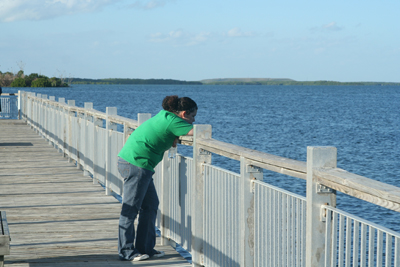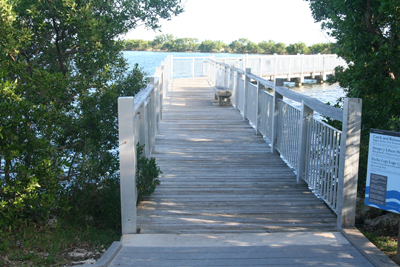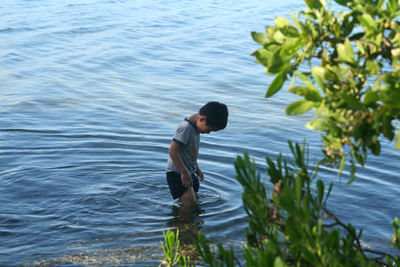
Convoy Point trail reveals park’s best
HOMESTEAD, Fla. — As the wrinkled face of 55-year-old fisherman Carlos Perez bakes in the South Florida heat, the prospects of catching anything on this mid-October day appear grim.
Shielding the sun as he looks eastward towards the horizon, he begins to remove the bait from one of his poles, throws the chum into the ocean and speaks to a young child watching him.
“Look, no hook.”
To the boy’s great amusement, three fish rise to the surface, fighting for an afternoon snack. It would be easy to get aggravated on a day like today, when nothing is biting and the lines remain still.
| Click on the video at the left to see a slide show of scenes from Biscayne National Park photographed by writer Camron Ghorbi. |
For Perez, just like many visitors at Biscayne National Park, the jetty trail is never a place of frustration or discouragement.
“I love it here,” Perez said with a big smile on his face. “I can sit here all day and I’m happy, even if no fish come.”
Though only a quarter-mile long, the walking trail at Convoy Point serves a much bigger role at the park than its size might indicate. As the largest marine park in the National Park Service system, Biscayne’s biggest draws are the opportunity to snorkel six different shipwrecks and the glass-bottom boat tour that departs twice a day.
For Charles Gilford, visiting from his own slice of heaven in Nova Scotia, the short walking trail is much more appealing.
“You can do that snorkeling stuff anywhere, really,” the 65-year-old said. “I’ve got a farm back home where I thought I had the best view in the world. Then I sat on one of these benches and I can’t bring myself to get up.”
 |
Park visitor Mario Escobar, 22, looks into Biscayne Bay from the walkway in front of the Fascell Visitor Center at Biscayne National Park (Photos by Camron Ghorbi). |
Military families gather on the lawn outside the Dante Fascell Visitor Center for a barbeque and some spirited games of bean bag toss.
Visitors from Beijing make their way to the bridge, waiting to feed the fish with a loaf of bread.
Laughing and smiling together on an after-school excursion, a high school couple quits its handholding in order to skip rocks out near the end of the trail.
Though Park Ranger Astrid Rybeck mentions the value of the quarter-mile stretch as a “waiting area” to pass the time before boat tours, it’s clear the jetty trail is a much more important part of the park than recognizable at first glance.
“People hang out on the trail all the time, with no intention of ever going on a boat tour,” Rybeck, a Biscayne interpretive ranger since 2006, said. “I know most people come for the water, but a lot of people just come for the view.”
Looking out at the horizon from one of the countless vantage points on the trail, it should come as no surprise why fishermen like Perez and visitors like Gilford can’t bring themselves to leave. Out near the horizon, as the ocean melts into the sky in a seamless collision of blue, the faint images of boats add a semblance of reality to the view.
| At right, a short pedestrian bridge leads onto the bay for visitors taking the Visitor Center walk to the jetty. Below, visitor Will Park, 3, wades in shallow water of the bay. |  |
Leaning against the side of the bridge and staring out at the water, 18-year-old Carolyn Tavish looks at peace.
“My mother and I used to walk here all the time when I was little,” Tavish said. “Now that she’s gone, I try to come as much as I can just to remember what it was like.”
Of the 175,000 protected acres and 300 square miles of Biscayne, a minute fraction is accessible by foot. Boasting the only living coral reef in the continental United States, the park encompasses two-thirds of Biscayne Bay, one of the most frequented scuba diving destinations in the country. As tourists line up for the next glass-bottom boat departure, Tavish opts for the familiarity of land over the unknown of the sea.
“I know a lot of people come here to do that stuff, but I just come here to relax,” Tavish said. “When I get overwhelmed, this is the first place I come to. It helps me breathe easy.”
Though covering only a short distance of the shoreline, the trail itself has multiple sub-sections that fulfill a variety of roles. Near the beginning of the trail, grills and picnic tables are set-up on an adjacent patch of grass. Closer to the middle, a short bridge serves as the perfect post for fishermen. And further towards the end, the benches and nooks that line the narrow path are ideal for quiet and relaxation.
“ How could you not enjoy this?” Tavish said. “If you can’t find peace out here, then you can’t find it anywhere.”
How could you not enjoy this?” Tavish said. “If you can’t find peace out here, then you can’t find it anywhere.”
All along the trail, different informational signs help illustrate Biscayne National Park, both past and present.
Not only are there displays depicting the history of the park and the Spanish explorers who found it, but many more regarding the types of fish and wildlife living in the surrounding waters.
Though some casually engage in the signage, many simply drop their concerns to revel in the all-encompassing tranquility that characterizes the walking trail at Biscayne National Park; to do otherwise would seem impossible.
“I’ve never enjoyed something like this,” Gilford said. “This is my first time down here, and God willing, it won’t be my last.”
If You Go
Biscayne National Park, 9700 SW 328th St., Homestead, Fla., 33033.
Park is accessible from the north by both the Florida Turnpike and U.S. 1, and the south by U.S. 1. On U.S. 1, take the turn onto SW 328th Street. On the Florida Turnpike, take Exit 6 (Speedway Boulevard) and continue onto SW 328th Street.
Free admission to the park for all. Dante Fascell Visitor Center has restroom facilities, maps of the park, and a free park exhibit and accompanying short film. Snorkel tours leave twice a day from Convoy Point, ranging from $30 to $50. Walking trail is open during normal park hours. Convoy Point (which includes walking trail) opens from 7:30 a.m. to 5:30 p.m., while the Visitor Center stays open from 9 a.m. to 5 p.m.
Free parking and use of grills and picnic tables along the trail.

Comments are Closed